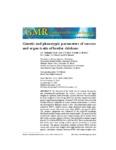Use este identificador para citar ou linkar para este item:
http://www.alice.cnptia.embrapa.br/alice/handle/doc/1003219| Título: | Genetic and phenotypic parameters of carcass and organ traits of broiler chickens. |
| Autoria: | VENTURINI, G. C.  CRUZ, V. A. R. da   ROSA, J. O.   BALDI, F.   EL FARO, L.   LEDUR, M. C.   PEIXOTO, J. de O.   MUNARI, D. P.   |
| Afiliação: | GUILHERME COSTA VENTURINI, Faculdade de Ciências Agrárias e Veterinárias. UNESP.; VALDECY APARECIDA ROCHA DA CRUZ, Faculdade de Ciências Agrárias e Veterinárias. UNESP.; JAQUELINE OLIVEIRA ROSA, Faculdade de Ciências Agrárias e Veterinárias. UNESP.; FERNANDO SEBASTIÁN BALDI REY, Faculdade de Ciências Agrárias e Veterinárias. UNESP.; LENIRA EL FARO ZADRA, Instituto de Zootecnia. Estação Experimental de Sertãozinho; MONICA CORREA LEDUR, CNPSA; JANE DE OLIVEIRA PEIXOTO, CNPSA; DANÍSIO PRADO MUNARI, Faculdade de Ciências Agrárias e Veterinárias. UNESP. |
| Ano de publicação: | 2014 |
| Referência: | Genetics and Molecular Research, Ribeirão Preto, v. 13, n. 4, p. 10294-10300. |
| Conteúdo: | The objective of this study was to estimate the genetic and environmental parameters for carcass, carcass part, and organ weights in a paternal strain of broiler chickens that was selected mainly for body weight at 42 days of age (BW42) to provide support for poultry genetic improvement programs. A total of 1448 chickens were used that resulted from the expansion of a pure paternal strain named TT, which was developed by Embrapa Suínos e Aves. The following weights were evaluated: BW42, chilled carcass, wing, drumstick meat, thigh meat, breast meat, breast fillet, back, liver, heart (HRT), and gizzard (GIZ). The variance component was estimated by the restricted maximum likelihood method using a multi-trait animal model. The general model included the additive genetic and residual random effects and the fixed effect of the sex-hatch group (10 levels). The heritability estimates ranged from 0.27 ± 0.06 for HRT to 0.44 ± 0.08 for GIZ. These results indicated that all the traits have enough additive genetic variability to respond to selection. The genetic correlation estimates between BW42 and the carcass and carcass part weights were high and positive. However, the genetic correlation estimates between BW42 and organ weights were low. In this population, the carcass traits might respond indirectly to selection applied to BW42. It can be concluded that selection to increase BW42 is not effective in improving broiler organ weight. Therefore, to obtain suitable genetic improvement for these traits, the selection indexes for broilers should include organ weight-based criteria. |
| Thesagro: | Genética animal Frango de corte Carcaça |
| NAL Thesaurus: | Animal genetics Broiler chickens Fillet quality |
| Palavras-chave: | Peito de frango Qualidade de filé Carcass Chicken breast |
| Digital Object Identifier: | http://dx.doi.org/10.4238/2014 |
| Tipo do material: | Artigo de periódico |
| Acesso: | openAccess |
| Aparece nas coleções: | Artigo em periódico indexado (CNPSA)  |
Arquivos associados a este item:
| Arquivo | Descrição | Tamanho | Formato | |
|---|---|---|---|---|
| final7769.pdf | 281,85 kB | Adobe PDF |  Visualizar/Abrir |









